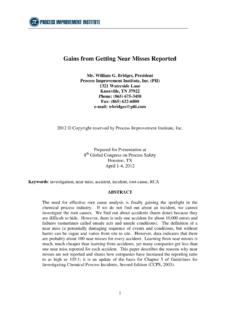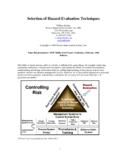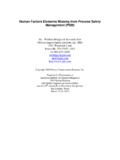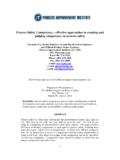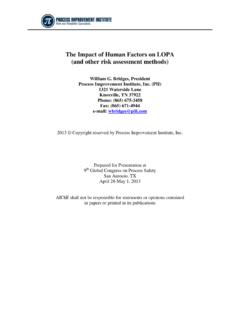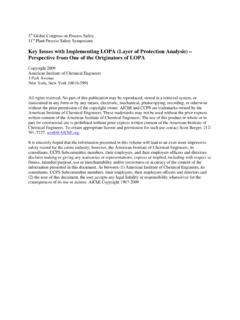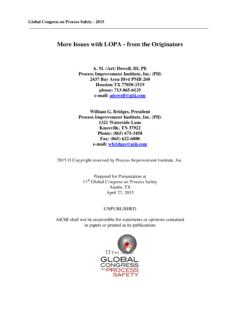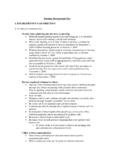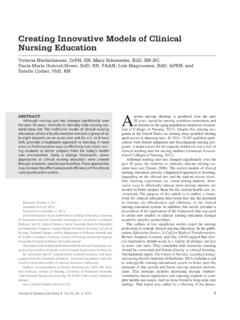Transcription of Optimizing Qualitative Hazard Evaluations for …
1 Optimizing Qualitative Hazard Evaluations for maximized Brainstorming (or How to Complete A PHA/HAZOP Meetings in One-Third the Time Currently Required while Finding More Scenarios ). William (Bill) Bridges and Revonda Tew Process Improvement Institute, Inc. (PII). Knoxville, TN, USA. & Copyright 2009 Process Improvement Institute, Inc. Prepared for Presentation at American Institute of Chemical Engineers 2009 Spring National Meeting 5th Global Congress on Process Safety 43rd Annual Loss Prevention Symposium Tampa, Florida April 26 30, 2009. AIChE shall not be responsible for statements or opinions contained in papers or printed in its publications This paper discusses the lessons gleaned from more than 5000 Qualitative Hazard Evaluations completed by the authors and compatriots over the past 18-years. The learnings were from project risk reviews, management of change (MOC) risk reviews, full unit process Hazard analyses (PHAs), and PHA revalidations. (All of these Evaluations fall within the Qualitative category of CCPS's Hazard Identifications and Risk Assessments [HIRAs], required in the Risk-Based Process Safety [RBPS] guide [CCPS, 2007].)
2 The experience covers all chemical and related industry. The paper shares secrets that will speed up your Hazard Evaluations while not sacrificing thoroughness. Issues covered include: Should you project your notes during the meetings? Should you use dedicated software? Should you have a dedicated scribe? Should you define the methods and make sections/nodes ahead of the meetings? What methods should you choose? What documentation rules speed up the meeting? What facilitation rules speed up the meetings without crimping brainstorming? What mistakes kill brainstorming and also slow the meetings? Data based on thousands of PHAs is presented, along with a condensed set of optimization rules. Background: PHA optimization is executing the PHA analysis with practices that are thorough and efficient. One key to optimization is Optimizing PHA Team Leadership the PHA leader's ability through training and practice to run efficient meetings while driving the team to make sound engineering- and operationally-based risk decisions.
3 In addition, developing, implementing, and maintaining a PHA management practice with detailed procedures and rules for conducting PHAs is necessary to ensure consistent and efficient implementation. However, PHA optimization is also very dependent on the strength of other process safety management (PSM) practices. The full implementation of these strong PSM elements, over time, will lead to better data needed to conduct PHAs. Elements for Optimizing PHAs PHA Team Leadership PHA Rules Implementation of Strong PSM Management Practices, related to PHA. This paper presents PHA team leadership techniques and rules, discusses content of PHA. management practice, policy, and procedures, and explains the relationship of PHAs with some other PSM elements where if those elements are weak, can impact the quality of the PHA and increase the PHA meeting or documentation time. Source of the Optimized Rules: The rules presented in this paper were developed through our efforts in conducting thousands of PHAs, each with slight variations (planned and unplanned experiments).
4 The rules were established with the goal of minimizing the effort it takes to complete a thorough PHA. The data set for these rules include: 18-years of PHAs More than 5000 PHAs performed under contract for more than 200 clients PHAs were performed by more than 50 leaders and 30 scribes Teams were all composed of excellent, required members and often some optional team members Leader and scribe used various commercial software packages Optimized Rules for PHA Team Leadership The rules presented in this paper will be new to most of the readers. Some of the rules will be quite surprising (even controversial) and, so at first, may not be readily accepted. Since these rules have been difficult to develop and, until now, have been closely held by a few very experienced PHA leaders and instructors, we recommend that readers give these rules a try. We also understand that some readers will ask: Why optimize PHAs?; Aren't more meetings and more documentation better for safety?
5 The answer is no, as will be explained in detail later. In short, inefficient PHAs can burnout teams (lower the brainstorming and causing accident scenarios to be missed). Also, if a PHA takes 3-times longer to complete than it should, then company leaders will be reluctant to invest more in aspects of PHAs where they are currently weak. For example, many companies do not perform a thorough analysis of the risk for startup, shutdown, and on-line maintenance modes of operation; the reason normally given is that the analysis of these modes of operation takes too long. Yet, actually the PHA of the normal mode is taking too long and so the company has no time left for the analysis of procedures for startup and shutdown modes of operation. If these PHAs for the normal mode of operation are optimized, the organization will have time for thoroughly analyzing the non-routine modes (typically discontinuous modes) of operation and the organization will still have a net savings overall!
6 This point is critical since 60-70% of catastrophic accidents occur during non-routine modes of operation. The Figure below illustrates this point: Table I & Table II list best practices for executing efficient PHA meetings. These best practice rules for Optimizing PHAs are categorized in Table I as meeting preparation, leader facilitation, and documentation. Table II further summarizes some best practices for leader facilitation and documentation. Meeting Preparation - Pre-populating the tables with the appropriate deviations will help the leader to quickly transition from deviation-to-deviation within a node, and also transition between analysis nodes or sections. Having a scribe in the meeting (for analysis longer than 4-hours of meeting time) can help tremendously and easily pays for itself. While the scribe is completing the summary of the team's discussion, the leader can move on to the next topic of discussion. Leader Facilitation - The PHA leader's ability to run efficient meetings requires training and practice.
7 The Leader must be trained in best practices (not merely what guidewords to ask) and then must be coached through many sessions to practice what he or she has learned. The leader must have at least 10-years of hands-on experience in process operations and plant engineering. Other factors include the elimination of projecting meeting notes for the team to view, which tends to divert the team from brainstorming and instead focuses them on evaluating what the scribe is documenting. As a result, the leader tends to wait for the scribe to catch up before leading the team into the next deviation analysis. Additionally, one important rule is for the leader to drive the team to make sound risk decisions as soon as possible in the discussion. Documentation - Though not as important at the team meetings, documentation of the meeting results is nonetheless critical for the meeting results to be useful to others. There are many styles of documentation, but some styles are more efficient than others.
8 Tables I and II show the styles that have proven best. Note: The rules shaded in Table I are considered necessary for any team to be (1) compliant with government and industry standards or (2) are generally understood universally already, and therefore are considered a minimum requirement or common practice and so are NOT. considered Optimization rules (but they are rules nonetheless). TABLE I. General Rules for Optimized PHAs Best Practice Rule Typical of Current PHAs More details on Best Practice ( , how to optimize for efficiency and thoroughness). Consolidate Studies Sometimes large plants are broken into Consider analyzing an entire unit instead of analyzing processes within a unit under From Risk Based smaller units and the PHAs are performed separate PHAs. Efficiencies will be gained because the process safety information should Process Safety, CCPS separately for each unit. Most companies overlap, the team members will be almost identical, except maybe for operators.
9 Also, this 2007, page 230 already follow this rule. Therefore, we have allows more rapid linking of one discussion to other discussions in other nodes, thereby not included it in our estimate of potential reducing repetition. Be mindful though that too many consecutive meeting days may savings. require team member substitutions. Following this rule can take one-half of the time of separate, small PHAs that are difficult to link. Standardize Checklists Since the mid-1990s, many companies Saves time to have these tools available instead of requiring each leader to develop their From Risk Based already follow this rule. Therefore, we have own. This is especially true for checklists, such as Human Factors Issues and Facility Process Safety, CCPS, not included it in our estimate of potential Siting Issues; these two checklists have been shared across the industry since the mid- page 230 savings. 1990s. For best efficiency, use these checklists only at the end of a meeting to ensure you have not missed any issues during the pure brainstorming portion of the PHA; using them too early will overwork the checklist issues.
10 Leader and scribe Many (perhaps more than half) develop the A leader/scribe can develop the total nodes before the start of the first meeting. This should develop nodes nodes during the team meetings. provides all of the blank spaces for each possible issue, so the scribe can quickly document ahead of the team issues that come up ahead of time. This rule is mandatory if linking is used, as described meeting later. This rule can save 10% of the meeting time and saves a little after meeting time, as well. Make sure to follow Most teams use other software that requires Pre-populating nodes with a standard set of deviations or what-if/checklist issues can node/section manually choosing each deviation to use for save 10% of total project time and reduces meeting preparation time by 70%. This definitions that match each section/node. type of optimization is what software should do for us. LEADER or PHA Pro 7 software (see discussion of software later). Develop and use only A majority of team leaders do not know the A new leader (those who have performed 0-2 PHAs on their own) will take 3-times as a trained and rules below and therefore do not get the much time to cover the same issues and will not document the issues as well.
